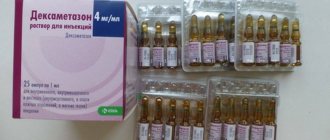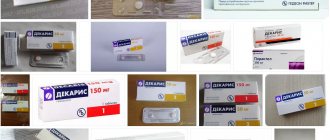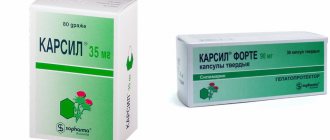Pharmacological properties of the drug Halidor
Halidor has a myotropic antispasmodic and vasodilator effect. Reduces the tone and motor activity of smooth muscles of internal organs. The blood pressure level is slightly affected. Has weak local anesthetic activity. Causes a moderate sedative effect. Inhibits platelet aggregation. Quickly and completely absorbed into the gastrointestinal tract. The maximum concentration in blood plasma is achieved 3 hours after administration. The half-life is 6 hours. About 97% of the dose taken is excreted in the urine in the form of inactive metabolites.
Indications for use of the drug Halidor
The drug is used to treat:
- cerebrovascular accidents of various origins;
- to relieve neurological symptoms (dizziness, headache, sleep disturbance, etc.);
- cerebral angiospastic syndromes;
- peripheral circulatory disorders;
- vascular diseases of the eyes;
- arterial spasm, postoperative and post-traumatic circulatory disorders, etc.;
- obliterating diseases (obliterating arteriosclerosis, diabetic angiopathy).
In cardiology:
- to increase heart rate with mild sinus node weakness;
- with sinus bradycardia, symptoms of vagotonic influence on the heart;
- as an auxiliary therapy for ischemic heart disease.
Visceral spasm:
- gastrointestinal vasospasm, gastritis, enteritis, colitis, tenesmus, cholecystopathy, cholelithiasis, postcholecystectomy syndrome.
In urology:
- Bladder tenesmus as an auxiliary therapy for nephrolithiasis.
Side effects
Side effects from the gastrointestinal tract may include abdominal pain, a feeling of fullness, nausea, and vomiting. From the side of the central nervous system: anxiety, dizziness, gait disturbance, tremor, headache, insomnia, very rarely hallucinations may develop.
There may be cases of tachyarrhythmia (ventricular or atrial; the development is significantly more common when used together with other proarrhythmogenic drugs).
Other side effects can be expressed in a state of general malaise, weight gain, allergic reactions, transient increases in the activity of ASAT, ALAT, as well as a decrease in the number of leukocytes; there is rarely a possibility of thrombophlebitis with intravenous administration.
Overdose
An overdose of Halidor is rare. Symptoms in case of overdose: tachycardia, drop in blood pressure, drowsiness, urinary incontinence; in case of severe overdose, epileptiform seizures are possible.
Due to the lack of a specific antidote, in cases of overdose, symptomatic therapy is used. Benzodiazepines are indicated to relieve seizures. The effectiveness of dialysis for bencyclane overdose is questionable, but there is no reliable data.
Use of the drug Halidor
Tablets For periodic use, a single dose is 1-2 tablets (100-200 mg), a daily dose is 300-400 mg, a maximum daily dose is 4 tablets (400 mg). Long-term treatment: 3 tablets (300 mg) per day for 3–4 weeks, then 1 tablet (100 mg) 2 times a day. Injection solution For adults: in acute cases, 50–100 mg (1–2 ampoules) IV, intra-arterial slow stream or 50 mg (1 ampoule) IM 1–2 times a day. The drug is diluted with physiological solution. The daily dose of Halidor should not exceed 150–200 mg.
Halidor tablets 100 mg No. 50 No. 1
Name
Halidor tab. 100 mg per vial. No. 50 in pack. No. 1
Description
Tablets are white or grayish-white, round, flat, beveled, with “HALIDOR” engraved on one side, with a slight characteristic odor.
Main active ingredient
Bencyclane
Release form
The solution for intravenous and intramuscular administration is transparent, colorless, odorless. 1 amp. active substance: bencyclane fumarate 50 mg Excipients: sodium chloride for parenteral dosage forms - 8 mg, water for injection - up to 2 ml. 2 ml - ampoules (5) - contour cell packaging (2) - cardboard packs. 2 ml - ampoules (5) - contour cell packaging (10) - cardboard boxes. Tablets are white or grayish-white, round, flat, beveled, with “HALIDOR” engraved on one side, with a slight characteristic odor. 1 tab. bencyclane fumarate 100 mg Excipients: potato starch, polyvinyl acetate, magnesium stearate, carbomer 934 R, sodium carboxymethyl starch (type A), colloidal anhydrous silicon dioxide, talc. 50 pcs. - dark glass bottles (1) - cardboard packs.
Dosage
100 mg per vial. No. 50 in pack. No. 1
special instructions
When prescribing Halidor simultaneously with drugs that cause hypokalemia, cardiac glycosides, and drugs that inhibit myocardial function, the daily dose of Halidor should not exceed 150-200 mg. When used parenterally, injection sites should be changed, because the drug can cause damage to the vascular endothelium and thrombophlebitis. You should refrain from parenteral administration of the drug to patients with severe cardiovascular or respiratory failure, predisposed to collapse, as well as prostatic hypertrophy and urinary retention (the degree of retention increases with relaxation of the bladder muscles). With long-term use of Halidor, systematic (at least once every 2 months) laboratory testing of the rheological properties of blood is recommended. Impact on the ability to drive vehicles and operate machinery. At the beginning of the course of treatment, patients should take special care when driving vehicles and other potentially dangerous activities.
pharmachologic effect
Myotropic antispasmodic with a pronounced vasodilating effect. The vasodilatory effect of bencyclane is mainly associated with its ability to block calcium channels, antiserotonin action, and to a lesser extent - with blockade of sympathetic ganglia. Bencyclane can cause dose-dependent suppression of Na+/K+-dependent ATPase and platelet and erythrocyte aggregation, as well as an increase in erythrocyte elasticity. These effects are observed mainly in peripheral vessels, coronary arteries and cerebral vessels. In addition, bencyclane has an antispasmodic effect on the visceral muscles (gastrointestinal tract, urinary tract, respiratory organs). The drug causes a slight increase in heart rate. Its weak tranquilizing effect is also known.
Pharmacokinetics
Absorption After taking the drug orally, bencyclane is absorbed from the gastrointestinal tract quickly and almost completely. Cmax in blood plasma is achieved 2-8 hours (usually 3 hours) after oral administration. Due to the “first pass” effect through the liver, the bioavailability of the drug after oral administration is 25-35%. Distribution Approximately 30-40% of the amount of bencyclane in the circulating blood is associated with plasma proteins, 30% with erythrocytes, 10% with platelets; the free fraction is 20%. Metabolism Metabolism occurs in the liver, mainly in two ways: dealkylation produces a demethylated derivative, cleavage of the ester bond produces benzoic acid, which is subsequently converted to hippuric acid. Excretion T1/2 is 6-10 hours. It is excreted mainly in the urine in the form of inactive metabolites, but also unchanged (2-3%). Most metabolites (90%) are excreted in unconjugated form, and a small part is excreted in conjugated form (approximately 50% as a conjugate with glucuronic acid). The total clearance is 40 l/h, renal clearance is less than 1 l/h. Pharmacokinetics in special clinical cases T1/2 does not change in elderly patients, as well as in cases of impaired renal and hepatic function.
Indications for use
Vascular diseases: - peripheral vascular diseases - Raynaud's disease, other diseases with acrocyanosis and vasospasm, as well as chronic occlusive arterial diseases; — cerebral vascular diseases: in complex therapy of acute and chronic cerebral ischemia. Elimination of spasm of internal organs: - gastrointestinal diseases - gastroenteritis of various etiologies (especially infectious), infectious and inflammatory colitis, functional diseases of the large intestine, tenesmus, postoperative flatulence, cholecystitis, cholelithiasis, condition after cholecystectomy, motility disorders with dyskinesia of the sphincter of Oddi, peptic ulcer of the stomach and duodenum (as part of combination therapy); - urological syndromes: spasms and tenesmus of the bladder, concomitant therapy for urolithiasis (in combination with analgesics for renal colic). Preparation for instrumental research methods in urology.
Directions for use and doses
Vascular diseases Oral Halidor® is prescribed 100 mg 3 times a day for 2-3 months. The maximum daily dose for oral administration is 400 mg. The interval between courses is 2-3 months. The drug can also be used as an intravenous infusion at a daily dose of 200 mg, divided into 2 administrations. Before the infusion, 100 mg (4 ml) of the drug is diluted in 100-200 ml of isotonic sodium chloride solution and administered intravenously for 1 hour 2 times a day. To eliminate spasms of internal organs, Oral Halidor® is prescribed in a dose of 100-200 mg once, but not more than 400 mg/day. For maintenance therapy, 100 mg 3 times a day is prescribed for 3-4 weeks, then 100 mg 2 times a day. The duration of treatment is determined individually depending on the disappearance of the symptoms of the disease and, as a rule, does not exceed 1-2 months. In acute cases, Halidor® is administered intravenously slowly at a dose of 100-200 mg (4-8 ml) or intramuscularly at a dose of 50 mg (2 ml). Before intravenous administration, the required amount of solution is diluted with isotonic sodium chloride solution to 10-20 ml. The course of treatment is 2-3 weeks, followed by transfer of the patient, if necessary, to taking the drug Halidor® orally.
Use during pregnancy and lactation
Data from preclinical studies did not reveal any embryotoxic or teratogenic effects, however, adequate and strictly controlled clinical studies on the use of the drug Halidor® during pregnancy and lactation have not been conducted. Therefore, administration of the drug to patients in the first trimester of pregnancy is not recommended. If it is necessary to use the drug during lactation, the issue of stopping breastfeeding during treatment should be decided.
Precautionary measures
Contraindicated in severe liver failure. Contraindicated in severe renal failure. Contraindications: children and adolescents under 18 years of age (insufficient experience of use). Contraindicated in children and adolescents under 18 years of age.
Interaction with other drugs
When used simultaneously, Halidor® enhances the inhibitory effect of anesthetics and sedatives on the central nervous system. With simultaneous use of Halidor with sympathomimetics, the risk of developing tachycardia, atrial and ventricular tachyarrhythmias increases. With the simultaneous use of Halidor and drugs that reduce the level of potassium in the blood (including diuretics, cardiac glycosides), and quinidine, a summation of proarrhythmogenic effects is possible. When Halidor is used simultaneously with digitalis preparations, the risk of arrhythmia increases due to an overdose of cardiac glycosides. When using Halidor simultaneously with beta-blockers, it may be necessary to select the dose of the beta-blocker due to the opposite chronotropic effects (negative with beta-blockers and positive with bencyclane). When Halidor is used simultaneously with calcium channel blockers and other antihypertensive drugs, their effect may be enhanced. With the simultaneous use of Halidor with drugs that cause side effects in the form of spasmophilia, the summation of these effects is possible. With the simultaneous use of Halidor with acetylsalicylic acid, increased inhibition of platelet aggregation is possible.
Contraindications
- severe respiratory failure; - severe renal failure; - severe liver failure; - decompensated heart failure; - acute myocardial infarction; - AV block; - epilepsy and other forms of spasmophilia; - recent hemorrhagic stroke; - traumatic brain injury (within the last 12 months); - pregnancy; - lactation period (breastfeeding); - children and adolescents under 18 years of age (insufficient experience of use); - hypersensitivity to the components of the drug.
Compound
1 tab. bencyclane fumarate 100 mg Excipients: potato starch, polyvinyl acetate, magnesium stearate, carbomer 934 R, sodium carboxymethyl starch (type A), colloidal anhydrous silicon dioxide, talc. 50 pcs. - dark glass bottles (1) - cardboard packs.
Overdose
Symptoms: increased heart rate, decreased blood pressure, collapse, impaired renal function, urinary incontinence, drowsiness, anxiety, and in severe cases, epileptiform seizures. Significant overdose can cause tonic and clonic convulsions. Treatment: symptomatic therapy. When taking a large number of tablets, gastric lavage should be performed. Benzodiazepines are recommended for the treatment of seizures. A specific antidote is not known. There is no data on the possible removal of bencyclane by dialysis.
Side effect
From the digestive system: dry mouth, abdominal pain, feeling of fullness, nausea, vomiting, increased activity of liver transaminases in the blood serum. From the central nervous system: anxiety, dizziness, headache, gait disturbance, tremor, sleep disturbances, insomnia, memory disorders; rarely - transient confused state of consciousness, epileptiform seizures, hallucinations; in isolated cases - symptoms of focal damage to the central nervous system. From the cardiovascular system: sometimes - atrial and ventricular tachyarrhythmia (especially when administered together with other proarrhythmogenic drugs). Other: general malaise, weight gain, leukopenia, allergic reactions; rarely - thrombophlebitis with intravenous administration.
Storage conditions
The drug should be stored out of the reach of children at a temperature of 15° to 25°C.
Special instructions for the use of the drug Halidor
Before prescribing the drug, liver and kidney function should be determined. When carrying out long-term therapy, it is necessary to monitor the hemogram every 2 months. Take with caution in case of prostate adenoma with impaired urine outflow. Restrictions in driving vehicles and other mechanisms depend on the individual characteristics of the patient (presence of sedation). It is not recommended to use the drug for the treatment of children and adolescents under the age of 18 years. When administering the drug parenterally, the injection sites should be changed to avoid damage to the vascular endothelium or the occurrence of thrombophlebitis.
Contraindications
The drug has a number of contraindications. These include hypersensitivity to bencyclane, cases of severe respiratory, renal, cardiac and hepatic failure, existing atrioventricular block or acute myocardial infarction.
Halidor is not used in cases of epilepsy, other forms of spasmophilia, as well as in cases of hemorrhagic stroke or severe traumatic brain injury suffered in the last year.
Due to the lack of reliable research on the use of Halidor in pregnant and lactating women, the use of Halidor is not recommended in the first trimester of pregnancy. It is also advisable to discontinue use during breastfeeding or stop breastfeeding for the entire duration of treatment.




